Light Fundamentals for Phone Cameras
Smartphone sensors are tiny, so they crave more light and smoother contrast. Favor soft sources, keep ISO low, and compose near light to minimize noise while revealing texture. Share your favorite softening hack below.
Light Fundamentals for Phone Cameras
Bright windows can clip highlights fast. Use exposure lock, lower by a stop, and turn subjects slightly from the brightest source to keep detail. Add negative fill to sculpt cheeks without overcrushing shadows. What works for you?


